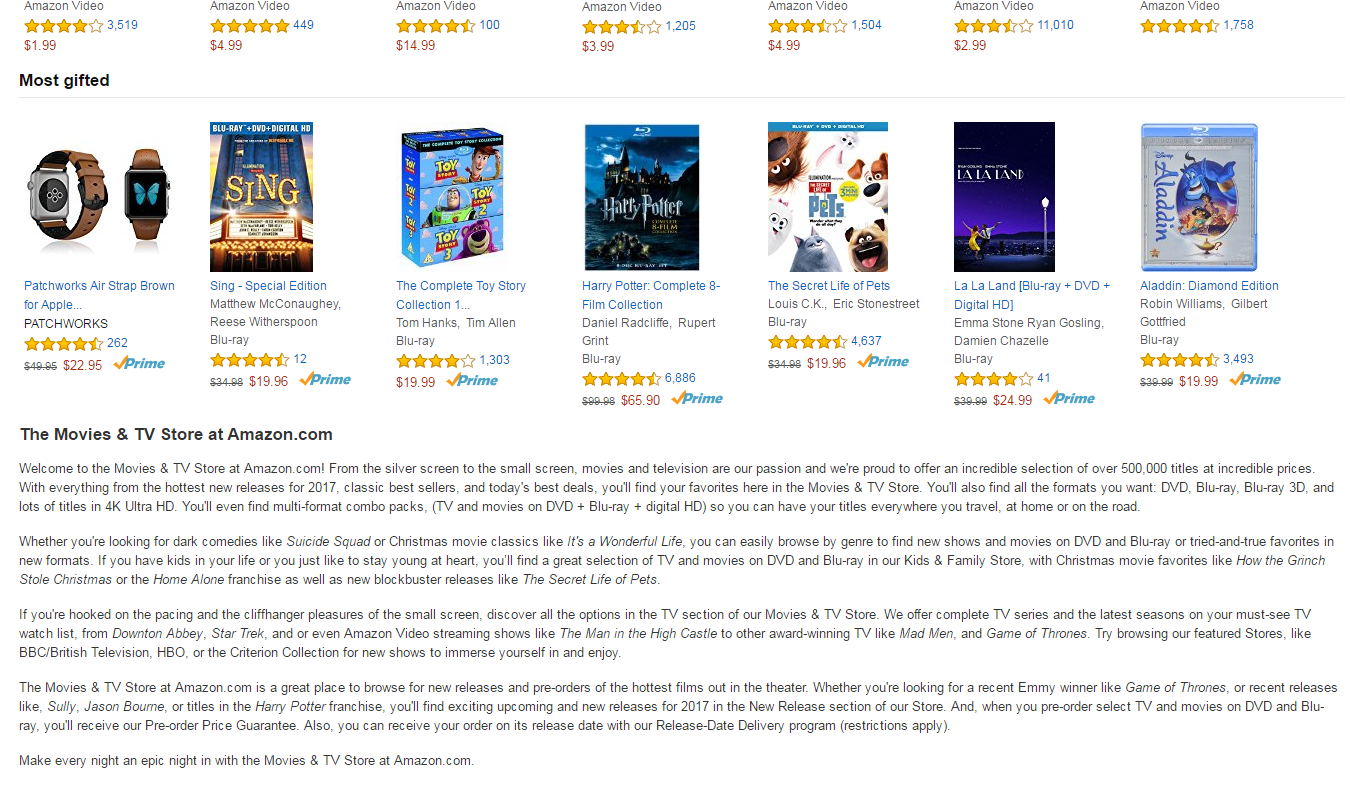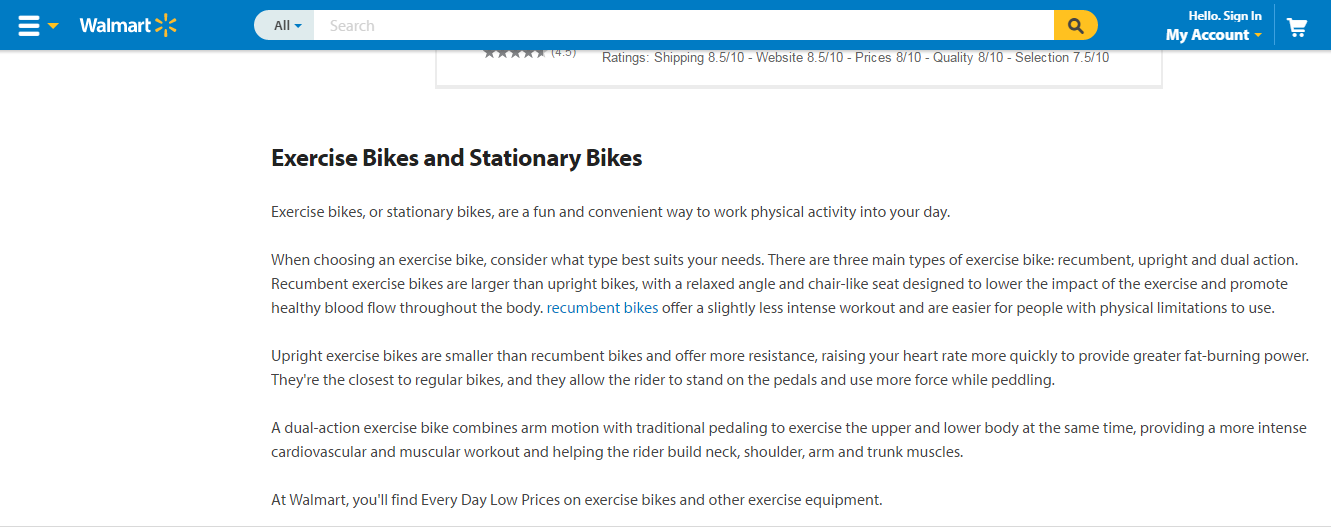I have been composing web content longer than…Well, longer than I can admit gracefully.
Through those years of content writing, the best practices, trends and techniques for compelling writing have changed immensely.
I occasionally catch myself reminiscing about the old days when “a web page must be 250 – 300 words and have a keyword density of approximately 10 – 15%.”
It was straightforward. It was practically muscle-memory. And the content did not even have to be especially helpful or high-quality because it was likely going to be tagged at the very bottom of a page where no one was actually going to view it.
Food for thought: sometimes the more things change, the more they stay the same. Right now, you could visit the site of one your favorite digital retailers and scroll to the bottom of one of their category pages and what comes into view?
At Amazon.com you may see:
And Walmart.com displays like this:
Well, what do you know? 200 – 400 words of keyword-centric content featuring a title with a keyword and a link with a keyword (in Walmart’s content). Very old school SEO content in these modern times on some huge retailer’s websites.
This content writing format is typical around the web, and there is actually a simple explanation for it. Most websites were not designed and developed for the content. They were designed to sell merchandise. So where do the words fit into that kind of design strategy?
Broadly speaking, they fit in near the bottom of the page.
This may seem counterproductive, but do not let that discourage you from creating better quality content and discovering more effective ways to get potential customers to find it.
The Standard Reminders
Before we dig deeper into how to write superior content, let’s revisit a few things you may have already heard, but should be addressed for the sake of thoroughness.
- Always be relevant to the page.
- Over-optimization will cancel out all your hard work.
- Write for a human being, not for a search engine.
Your Goal for Web Content Writing
Now that we covered that, let’s move forward by listing your objectives for web content:
- Increase the perceived value of the product or service.
- Reduce the perceived friction between a customer arriving on the site and making a purchase.
- Address the customer’s’ questions and concerns.
- Make their next step obvious and easy.
- Help the search engines understand the topic relevance of the page.
I must note that a few paragraphs tucked away at the end of the page are not particularly likely to achieve any of these objectives(possibly excepting #5).
Get The Voice Right
A lot of “creative” writers will discuss “the voice” of their writing like it is some magical beast that whispers like a muse to even the most discerning of customers.
While I agree that is a fantastical way to look at it, its is important that your brand does have a discernible voice.
The voice of your brand is how you speak or write about your business. It is the language you use to effectively communicate your brand's message and values to your customers and allows you to build stronger relationships with them. Share on XHow does one accomplish this?
By producing content that balances functional and emotional appeal. Let me put this another way, if your content only appeals to the emotional side of your customers, then you are not presenting rich, well-balanced content.
On the flipside, if you are only discussing the features, your content may read like an automobile repair manual.
This may seem to be a daunting task, but it is achievable if you focus your content toward the customer, instead of the company.
By showing that you understand the needs of your customers, you can appeal to their emotional sides, and demonstrate that your brand wants to build trust. After, you can display the features of your services or products and aid them in understanding how it will address their current concerns.
The most crucial thing about your brand’s voice, though, is that it should be aimed toward the customer. It should highlight on what they receive, not what you have.
You can transition away from saying:
“Our custom software is the solution. At [Great Company X], all of our apps are built to order, and we will make sure that they are made to your exact specifications.”
Toward saying:
“Your new, custom software solution has everything you need to deliver a smooth and intuitive user experience. Start building a new app that meets your exact specifications.”
See the difference?
Writing for SEO: What is Necessary and What Isn’t
We have covered the value of aiming the voice of your brand at and for your actual, living, breathing (wallet-opening) customers. That certainly does not mean we want to disregard search engines altogether. So, let’s discuss some vital SEO components.
Keywords
We cannot use these the same way we used to. Composing content for SEO is not about slipping keywords into content “as naturally as possible,” any more. There are more effective ways to go about it.
You will have more flexibility and cohesion with content composed to support a topic rather than content created merely to include a specific keyword. We have discussed why it may be damaging to focus solely on individual keywords to assess the success of your campaign, and the same applies to your content. Neither the digital environment nor your customers’ online behavior can be adequately represented with single keywords.
The typical approach for utilizing keywords is once in the title, the header, and the body, and that’s a general guideline. But if you start considering topics instead of specific keywords, you will begin to see new ways to connect to your other pages and get more results from your content.
Links
Links should help amplify the topic’s relevance. Do not muscle them into your content, and don’t link to irrelevant pages just to see a climb in your rankings. You can certainly link to important information on your site or blog or downloadable assets if they really help your potential clients understand your services or products.
The best way to determine link placement is to ask yourself if you’d be okay with someone leaving that page at that moment. If not, do not put a link in that particular spot.
Titles/Headlines
All marketing communication, including the titles and headlines on your brand’s website, should be geared toward the interests of your customers. Compose your headlines to spotlight what your visitors receive rather than what you have or what they have to do.
The goal of a headline is to 1) grab attention, and 2) give the reader a reason to read the rest of the content. You can do this by integrating a “point-first” structure, meaning that you put the weighted value at the beginning of the headline.
The Elements of Style
Writing – even writing for SEO – is not a mechanical process. There should always be some style and art. I have discovered this to be a common reason people believe they cannot effectively write their own content.
If you place yourself in this category, I suggest reading “The Elements of Style” by William Strunk and E.B. White. If you can master the stylistic and grammatical guidelines in this book, your written content will at least look and feel professional.
I would like to highlight a few guidelines from this book, since they address some of the problems I commonly to see in written web content. (They are numbered the same as in the book so you can refer back to it if needed.)
14. Use the active voice.
The active voice is usually more vigorous and direct than the passive voice:
“I shall always remember my first visit to Boston.”
This is much better than:
“My first visit to Boston will always be remembered by me.”
Also:
The habitual use of the active voice, however, makes for forcible writing. This is true not only in narrative concerned principally with action but in writing of any kind
You can avoid using the passive voice by never beginning sentences with “because of,” “with,” “to,” “when it comes to,” or using words like “have been,” or “being.”
15. Put statements in positive form.
Make definite assertions. Avoid tame, colorless, hesitating, noncommittal language. Use the word not as a means of denial or in antithesis, never as a means of evasion.
He was not very often on time. vs. He usually came late.
When composing web content, it may be tempting to start a phrase with: “not only does it do this, but it also does that.” Instead, simply say: “it does this AND it does that.”
Stay grammatically positive. This way you never have to discuss what your services or products and services can’t do.
16. Use definite, specific, concrete language.
Prefer the specific to the general, the definite to the vague, the concrete to the abstract.
I am a fan of how marketingexperiments.com sums us this guideline: “Clarity trumps persuasion.”
17. Omit Needless Words
Effective content writing is concise. A sentence should not contain unnecessary words, sentences or paragraphs, for the same reason that a drawing should have no unnecessary lines and a machine no unnecessary parts.
When writing for SEO focuses too heavily on cramming in all the right keywords, an amount of needless words may come along with them. This is not the end of the world, but you can use it to gauge if you are trying too hard to incorporate a specific keyword.
A Couple of Nitpicks
These are just a few small things I have observed, and we have already touched on whether or not grammar matters much in content marketing. But, throughout my journey, I have concluded that these are some guidelines that need addressing.
- The only people who use semicolons are English majors trying to prove they know how to use semicolons. For the rest of us, there are better ways to structure sentences.
- Do not use exclamation marks!!!!!!! Exclamation marks are for infomercials and car dealerships. I will allow you to use an exclamation mark the day you see apple.com or other multinational brands using them.
- Never begin your web content with a question. You are not here to question your visitors. They are here because they want an answer.
Stay Focused on Goals, Not Just Keywords
Writing effective web content can feel like walking a tightrope at times. You need to produce and publish high-quality content that exhibits the emotional and practical advantages of your services or products. It has to attract both potential customers and the search engines It has to immediately command attention yet be more than just clickbait.
It is possible to find this balance. The key is to focus on what you truly want.
Do you want to rank for certain keywords, or do you want more sales (or signups, or visitors)?
When you can answer that question appropriately, you will be on the right course to creating better-quality web content.
If you think seems like an enormous task, you would be correct. This process will require attention, time, effort and expertise. Fortunately help is available. At AdInfusion.com we have assembled a team of experts eager to help by providing you with compelling and effective content for your website. We can work with you on your content marketing, or show you how. Talk with us today, and learn how better web content can rank you up.



